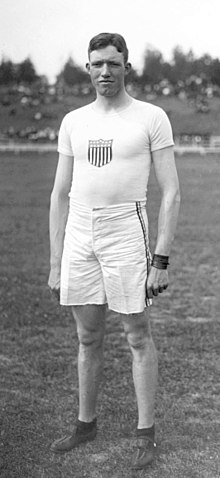Alma Richards

Alma Richards in 1912
|
|||||||||||||
| Personal information | |||||||||||||
|---|---|---|---|---|---|---|---|---|---|---|---|---|---|
| Born |
February 20, 1890 Parowan, Utah, U.S. |
||||||||||||
| Died | April 3, 1963 (aged 73) | ||||||||||||
| Height | 1.88 m (6 ft 2 in) | ||||||||||||
| Weight | 84 kg (185 lb) | ||||||||||||
| Sport | |||||||||||||
| Sport | High jump | ||||||||||||
| Club | BYU Cougars, Provo | ||||||||||||
|
Medal record
|
|||||||||||||
Alma Wilford Richards (February 20, 1890 – April 3, 1963) was a high jumper and was famous for being the first resident of Utah to win a gold medal at the Olympic Games, in 1912, in the running high jump event.
Born in Parowan, Utah, Alma Richards was an eighth grade farm boy who decided to stop school and explore the world. But shortly after his departure he met a Native American named Thomas Trueblood who convinced Richards to return to school.
At Brigham Young University in Provo, Utah, BYU coach Eugene L. Roberts saw Richards playing basketball, and instructed him to jump over a six-foot-high bar. He did so easily. The coach then proceeded to raise money to get Richards to the 1912 Trials in the High Jump. Richards proceeded to defeat American champion George Horine in the final and win the gold medal at the Stockholm Olympics in 1912.
Richards graduated from Brigham Young in 1913, and from Cornell University in 1917, where he was also a member of the Quill and Dagger society. The Olympics did wonders for his self-confidence, and whereas he was once just a marginal student, his aptitude and attitude now were boundless. He thrived at Cornell, in the classroom and on the track. He was the national AAU high jump champion in 1913 and later, as he expanded his repertoire, he became a decathlete as well.
By the time of the national AAU championships of 1915, held in conjunction with the World's Fair in San Francisco, he became the national decathlon champion, finishing some 500 points ahead of Avery Brundage, who would later head the International Olympic Committee.
...
Wikipedia
